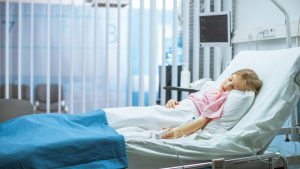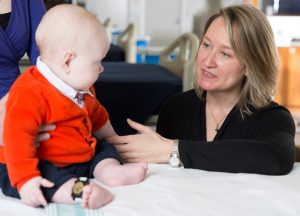For the first time, researchers from the University of Toronto and SickKids have been able to measure minute by minute how well children sleep, and their exposure to light and sound when hospitalized. The findings show that most hospitalized children experience significant sleep deprivation, with light and sound being two major contributors to sleep disruptions.
“This is the first time we can show how much of an impact light and sound have on awakenings in particular,” says Robyn Stremler, an Associate Professor at the Lawrence Bloomberg Faculty of Nursing and lead author of the study recently published in the JAMA Network Open.
“It has been assumed that when children are sick, they might be awake or have disrupted sleep due to pain or illness, but with these data, we are able to show that light and sound are the largest contributors to sleep problems and that sleep could and should be improved.”
Using actigraphy, Stremler and her team were able to objectively measure sleep by having patients wear a device on their ankle or wrist, that contained an accelerometer, similar to how a Fitbit measures sleep. They then assessed waking and sleep periods over the course of multiple nights. A sound and light meter were time-synchronized to the actigraphy device and were placed at the child’s bedside to measure any light and sound that occurred in the room around waking.
After considering additional variables, such as the reason for the child’s admission, how ill they were, whether they were residing in the PICU, and whether a parent or nurse was present in the room, the study found that light above 150 lux, which is about the same brightness as an incandescent bulb, and sound over 80 decibels, which is equivalent to a sudden loud noise, had the most significant impact on awakenings.
“What we can see is that these disruptions are part of the hospital environment and are modifiable, not easily but we can look at doing something about it,” says Stremler, who is also an Adjunct Scientist at SickKids Hospital.
One of the main reasons that patients get woken up at night is to monitor their temperature and blood pressure, or to administer certain medications. The sicker the patient is, the more likely they are going to need frequent assessments. Stremler explains that while there is a clinical imperative to check on these patients, there could be different choices made about their care that is more tailored to the patient.
“Rather than across the board, saying every four hours, patients need to have their vitals assessed, can we look more critically at patients to see if that level of monitoring is necessary? Can we make different choices about when medications are given? We need to think about how we can preserve as much sleep as possible given that we know that more sleep benefits patients’ physical and mental health and recovery,” says Stremler.
It is challenging however, Stremler notes, to modify these assessments because they involve policy change and care coordination across many groups of caregivers in hospital. Stremler’s previous research has shown that while nurses know that preserving sleep is important particularly for pediatric patients, they also express that it is a fine balance between providing care and ensuring there are limited sleep disruptions.
There are other ways that hospitals can help to reduce light and sound within a patient’s room. For hospitals designing new spaces, considerations can be given to how loudly or often doors close, lighting options, or how certain kinds of materials can absorb sound.
“We’ve suspected for some time that aspects of the environment were affecting sleep in young patients, but with this granular look at sleep intervals we are able to emphasize the importance of taking measures to reduce light and sound to improve sleep for patients who need it most.”

